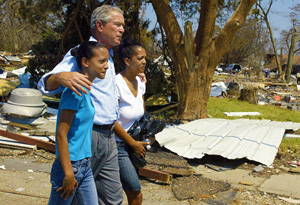Inside the Mind of President George W. Bush

Photo: Getty Images
PAGE 9
Another defining moment in President Bush's second term occurred on August 29, 2005. On this day, Hurricane Katrina, one of the deadliest storms in American history, hit the Gulf Coast. This natural disaster claimed the lives of at least 1,836 people, and property damage totaled more than $80 billion.
"It looked like a nuclear bomb had hit the coast," President Bush says.
In the days that followed Katrina's landfall, President Bush was criticized for slow relief response. But what many people don't know, he says, is that a state's governor—not the president—is in charge of emergency response. "The federal government's role is to help the governor," he says.
Five days after strong winds and floodwaters turned lives upside down, President Bush met with then Louisiana Gov. Kathleen Blanco and New Orleans Mayor Ray Nagin. He says tension was high. "Everybody's blaming everybody else so I said to the governor, 'Governor, give me the authority to send in federal troops,'" President Bush says. "By law, the president cannot send federal troops to conduct law enforcement without a declaration of insurrection and/or a request from the governor."
In his memoir, President Bush writes that Gov. Blanco requested 24 more hours to make her decision. "I'm not attempting to blame only the governor," he says. "We all could have done a better job."
Although he was unable to send in troops without the governor's permission, he says he could have sent in unarmed military personnel. "The problem was, I was listening to all the reports, many of which turned out not to be true—interestingly enough—that there was rape, murder and gunfire," he says. "I wasn't going to put a troop in harm's way without the capacity to defend him or herself. If I had to do it over again, knowing what I know today, I'd have sent them in with no weapons."
"It looked like a nuclear bomb had hit the coast," President Bush says.
In the days that followed Katrina's landfall, President Bush was criticized for slow relief response. But what many people don't know, he says, is that a state's governor—not the president—is in charge of emergency response. "The federal government's role is to help the governor," he says.
Five days after strong winds and floodwaters turned lives upside down, President Bush met with then Louisiana Gov. Kathleen Blanco and New Orleans Mayor Ray Nagin. He says tension was high. "Everybody's blaming everybody else so I said to the governor, 'Governor, give me the authority to send in federal troops,'" President Bush says. "By law, the president cannot send federal troops to conduct law enforcement without a declaration of insurrection and/or a request from the governor."
In his memoir, President Bush writes that Gov. Blanco requested 24 more hours to make her decision. "I'm not attempting to blame only the governor," he says. "We all could have done a better job."
Although he was unable to send in troops without the governor's permission, he says he could have sent in unarmed military personnel. "The problem was, I was listening to all the reports, many of which turned out not to be true—interestingly enough—that there was rape, murder and gunfire," he says. "I wasn't going to put a troop in harm's way without the capacity to defend him or herself. If I had to do it over again, knowing what I know today, I'd have sent them in with no weapons."



